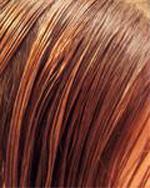|
Gentlemen prefer blondes... but gentlemen marry brunettes. Anita Loos |
|
Hair care and hair treatment
The healthy condition of the hair depends, to a very large extent, on the intake of sufficient amounts of essential nutrients in the daily diet. Hair is made of keratin, a protein, which also makes up the nails and the outer layer of our skin. One of the primary cause of hair loss is a high amount of the male hormone, dihydrotestosterone (DHT) within the hair follicle. DHT is produced from testosterone in the prostate, various adrenal glands, and the scalp. After a period of time, an over abundance of DHT causes the hair follicle to degrade and shortens the active phase of the hair. General debility, caused by severe or long standing illnesses like typhoid, syphilis, chronic cold, influenza and anaemia, also gives rise to hair disorders. It makes the roots of the hair weak, resulting in falling of hair. An unclean condition of the scalp can also cause loss of hair. This weakens the hair roots by blocking the pores with the collected dirt. Heredity is another predisposing factor which may cause hair to fall. There are many surgical procedures which will help to restore the hair from falling. Surgical restoration is the only permanent solution to baldness. It involves a series of operations that extract plugs of scalp from the sides and back of your head, where hair grows densely, and implant them on top and in front, where you are going bald. Scalp reduction is performed on patients with well-defined bald spots in the crown area of the scalp. It is sometimes done in conjunction with hair transplantaion to reduce the size of the bald scalp, especially in patients who do not have enough donor hair to cover the bald areas. Male pattern baldness that is the condition responsible for over 98% of all hair loss in men. It gets its name from the pattern of hair loss, which ultimately results in a horseshoe of hair that resides on the sides and back of the head, while the top of the head is completely bald. Some men begin MPB by losing the hair in their hairline. Others start in the crown. For women, hair loss is different. There is no set pattern for womens androgenic hair loss, which like MPB, occurs in the overwhelming majority of cases. Women can suffer from alopecia totalis and alopecia universalis just like men. Women can experience patch baldness for the same reasons as men (stress, poor nutrition, etc.), as well as due to hormonal changes from pregnancy and certain eating disorders. However, like men, the hair will generally grow back. The chief difference in womens androgenic hair loss from mens (both are hormone related) is that women tend to experience thinning that occurs in no particular pattern or part of the scalp. Unlike men, the scalp may not actually be totally denuded of hair, just thin to the point where the scalp is visible. Like men, however, the resulting hair loss is generally irreversible. The effectiveness of medications used to treat alopecia depends on the cause of hair loss, extent of the loss and individual response. Generally, treatment is less effective for more extensive cases of hair loss. New hair resulting from minoxidil use may be thinner and shorter than previous hair. But there can be enough regrowth for some people to hide their bald spots and have it blend with existing hair. New hair stops growing soon after you discontinue the use of minoxidil. If you experience minimal results within six months, your doctor may recommend discontinuing use. Side effects can include irritation of the scalp. Corticosteroids. Injections of cortisone into the scalp can treat alopecia areata. Treatment is usually repeated monthly. Doctors sometimes prescribe corticosteroid pills for extensive hair loss due to alopecia areata. Ointments and creams can also be used, but they may be less effective than injections. The innermost layer of hair is called the medulla and reflects light giving hair the various color tones it has. That's why hair color looks a lot different in sunlight than it does in the shade. The physical thickness and length of hair depends on what type of hair it is. Vellus hair is the fine fuzz type of hair that's often called peach fuzz. Its very fine and colorless and often almost invisible to the naked eye. The average Caucasian person has 5 million hairs of which 100,000 - 150,000 are on the head. Blondes not only have more fun, they also have more hair, about 140,000 more than average, Brunettes have slightly higher than average hair about 105,000 hairs, and redheads have a little less than average about 90,000 hairs. Many people (wrongly) will drop a handful of shampoo on their head and then rinse it off. Shampoo must be worked through all of your hair, as well as the scalp and hairline. Correct use of conditioners containing light proteins, such as hydrolyzed human hair keratin proteins, can help strengthen your hair. A good conditioner with these proteins can easily penetrate the hair shaft to replenish nutrients. These proteins can also repair split ends. Split ends develop after the protective cuticle has been stripped away from the end of hair fibers as a result of harsh chemicals or even vigorous brushing. Blond hair may turn yellow, fade or become dull due to UV exposure. Even natural brunette hair tends to develop reddish hues from sun exposure due to oxidation of melanin pigments. Androgenic alopecia develops when the hair follicle (the place under the skin where hair grows from) experiences a reduction in size, as well as a time reduction in the active growth phase. this translates into a simple fact: more and more of the hair follicles will spend time in the resting state where hair is shed once the state is completed. Fortunately, androgenic alopecia does not develop in all hair follicles at the same time. This is why some part of the scalp seems to be losing more hair than the other. Thyroid Disease - Both an over-active thyroid and an under-active thyroid can cause hair loss. Your physician can diagnosis thyroid disease with laboratory tests. Hair loss associated with thyroid disease can be reversed with proper treatment. Medications - Some prescription drugs may cause temporary hair shedding. Examples include some of the medicines used for the following: gout, arthritis, depression, heart problems, high blood pressure, or blood thinner. High doses of vitamin A may also cause hair shedding. Cancer Treatments - Some cancer treatments will cause hair cells to stop dividing. Hairs become thin and break off as they exit the scalp. This occurs one to three weeks after the treatment. Patients can lose up to 90 percent of their scalp hair. The hair will regrow after treatment ends. Patients may want to get wigs before treatment. Birth Control Pills - Women who lose hair while taking birth control pills usually have an inherited tendency for hair thinning. If hair thinning occurs, a woman can consult her gynecologist about switching to another birth control pill. When a women stops using oral contraceptives, she may notice that her hair begins shedding two or three months later. This may continue for six months when it usually stops. This is similar to hair loss after the birth of a child. See products which may help hair loss. Low Serum Iron - Iron deficiency occasionally produces hair loss. Some people don't have enough iron in their diets or may not fully absorb iron. Women who have heavy menstrual periods may develop iron deficiency. Low iron can be detected by laboratory tests and can be corrected by taking iron pills. Major Surgery/Chronic Illness - Anyone who has a major operation may notice increased hair shedding within one to three months afterwards. The condition reverses itself within a few months but people who have a severe chronic illness may shed hair indefinitely. Hair Pulling (Trichotillomania) - Children and sometimes adults will twist or pull their hair, brows or lashes until they come out. In children especially, this is often just a bad habit that gets better when the harmful effects of that habit are explained. Sometimes hair pulling can be a coping response to unpleasant stresses and occasionally is a sign of a serious problem needing the help of a mental health professional. Hair transplantation has come a long way from the days of "hair plugs" and a pleasing, natural result is now routine. It is an excellent option for treatment of hereditary hair loss in many men and women. Hair transplantation refers to the surgical movement of permanent hair with its roots to an area of bald or balding skin. Hair transplantation is an effective and permanent solution for hair loss. Hair transplantation is a surgical modality used for the correction of androgenic alopecia, scarring alopecia, and other causes of permanent alopecia. Hair transplantation is done under local anesthesia as an outpatient procedure. Hair and follicles are removed from the "donor area" of permanent hair along the back and sides of the head. This area is immediately camouflaged by the surrounding hair. The removed hair follicles are then divided into individual grafts of varying sizes. The smallest grafts contain 1-2 hairs and are often referred to as "follicular units" or "micrografts". Larger minigrafts may contain up to 6 hairs and can provide more density per graft. Choice of number and type of graft is made taking into account the patient's hair type, quality, color and the area to be transplanted. Once prepared the grafts (hair and its roots) are then inserted into the thin area. Since hair transplantation is a surgical procedure, all patients must be in good health. Hair transplantation is an office procedure that takes approximately four to eight hours depending on the extent of the planned procedure. Most people return to work two to five days after the surgery. The hair is your own, and just like all of your hair it grows, can be washed, curled, cleaned, permed and styled as desired. Once the transplants are completed, no special maintenance is required. Hair transplantation is a cost-competitive solution for hair loss. Other hair replacement alternatives require additional maintenance over the years. The cost depends on the amount of bald area that will need to be transplanted, and the desired thickness. More grafts are necessary to cover more bald or thin area and to maximize hair density. Because the procedure is individual, costs are usually determined individually. Many women today are proactive about seeking hair transplantation. They are unwilling to accept hair loss as an unavoidable fact of life. Scalp hair is a major component of the image women project to the world and they do not wish to have hair loss detract from that image. Hair loss is not "an inevitable sign of getting older". It has been reported in studies that about 80% of women experience some degree of hair loss before menopause. Much of this hair loss has a hereditary basis-female pattern hair loss.
Terms interpretationScalp Place for art works is here.
|

